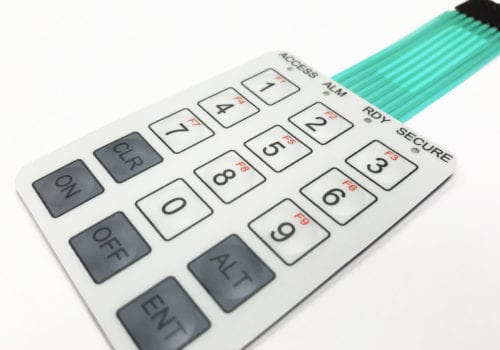Exactly How Membrane Layer Changes Contribute to the Resilience of Electronic Control Panels
Membrane layer switches play a vital function in boosting the toughness of electronic control panels, mostly via their multi-layered building which gives effective protection versus environmental factors such as moisture and dirt. The absence of moving parts substantially reduces the possibility of mechanical failures, making membrane switches ideal for requiring applications.
Definition of Membrane Switches

Membrane layer buttons are made to be slim and light-weight, making them ideal for applications where room is restricted. They can be made in various forms, dimensions, and colors, providing versatility in design that satisfies aesthetic and practical needs. In addition, membrane layer switches can incorporate numerous technologies, such as responsive feedback and LED indications, enhancing individual experience.
As a result of their construction, membrane switches are usually resistant to dirt, dampness, and basic wear, adding to their durability sought after environments. Their seamless design not only promotes simple cleansing yet additionally minimizes the danger of mechanical failing, making them a favored choice for makers seeking reliable user interfaces in their digital control panels.
Security Versus Ecological Elements
The design of membrane changes naturally gives a degree of protection versus various ecological variables, which is essential for maintaining capability in tough conditions - Membrane Switch. These switches are typically created with layers of adaptable products that shield interior parts from wetness, dirt, and pollutants. By encapsulating the circuitry, membrane layer changes reduce the risk of short circuits and deterioration, which can substantially harm performance
Furthermore, using durable adhesives and sealers during manufacturing improves their resistance to environmental obstacles. Membrane switches can sustain exposure to chemicals and solvents, making them ideal for markets such as food processing and medical care, where hygiene and cleanliness are paramount. Their smooth surface design likewise stops the accumulation of dirt and microorganisms, assisting in much easier cleansing and upkeep.
Temperature variations are another ecological worry, and membrane switches are engineered to work efficiently across a wide variety of temperature levels (Membrane Switch). This versatility makes certain that control panels stay operational in numerous setups, from industrial settings to customer electronics
Effect On Individual Communication
Individual interaction with digital control internet panels is significantly influenced by the design and performance of membrane switches. These switches give a tactile interface that boosts the overall individual experience, permitting intuitive navigation and control. Their receptive nature makes sure that users receive prompt comments upon activation, which is essential for tasks needing accuracy and effectiveness.
Moreover, the smooth surface area of membrane switches promotes very easy cleaning and upkeep, advertising user confidence in the dependability of the user interface. This tidiness is particularly important in settings where health is paramount, such as clinical or food processing setups. Additionally, the compact and light-weight layout of membrane layer switches adds to the visual appeal of control board, encouraging customer engagement with a modern and sleek appearance.
Additionally, the assimilation of aesthetic aspects, such as printed icons and backlighting, assists customers promptly determine functions, lowering the learning curve associated with brand-new equipment. Consequently, customers can operate gadgets much more effectively, leading to increased productivity and complete satisfaction. In summary, membrane layer buttons play a crucial role in boosting individual interaction by incorporating functionality, visual appeals, and ease of usage, ultimately bring about boosted operational effectiveness.
Design Flexibility and Personalization
Design adaptability and customization are important aspects of membrane buttons, enabling suppliers to tailor digital control board to specific applications and individual needs. This flexibility permits the combination of different layout aspects, such as shades, graphics, and textures, which can improve the aesthetic charm and customer interaction of the control panel.
Membrane buttons can be personalized in dimension and shape, accommodating a wide variety of gadgets and applications, from industrial equipment to consumer electronic devices. This flexibility makes sure that makers can develop instinctive user interfaces that straighten with user assumptions and operational demands. Additionally, the capacity to integrate one-of-a-kind features such as backlighting or tactile feedback better enhances functionality, enabling for a much more interactive experience.
Furthermore, the manufacturing procedure for membrane switches over supports the quick prototyping of layouts, enabling manufacturers to repeat and fine-tune their concepts promptly. This capacity not just increases the advancement timeline yet additionally makes sure that the final item meets certain practical and aesthetic criteria.

Cost-Effectiveness and Long Life
Cost-effectiveness and longevity are significant benefits of membrane switches, making them an attractive choice for producers and end-users alike. These buttons are typically much less pricey to produce than traditional mechanical switches, primarily due to their check these guys out simplified production processes and the lowered variety of parts needed. This cost advantage expands not only to preliminary production but also to lasting functional expenses, as membrane buttons often need less upkeep and have a reduced failure price.
Additionally, the durability of membrane changes adds web to their general value. Constructed from long lasting materials, they are immune to ecological variables such as dampness, dirt, and chemicals, which can lead to premature wear in other button types. The lack of moving components lessens mechanical failing, enabling membrane switches to maintain functionality over expanded durations.
This resilience is particularly useful in applications calling for regular efficiency under requiring problems, such as medical devices and commercial devices. Inevitably, the combination of cost-effectiveness and durability makes membrane layer switches over an economically sensible option for makers, giving reliable remedies that hold up against the test of time while enhancing budgetary factors to consider.
Conclusion
To conclude, membrane layer buttons considerably enhance the toughness of digital control panels with their robust building and protective features. By effectively protecting circuitry from environmental hazards and minimizing the risk of mechanical failing, these buttons make certain regular efficiency in requiring applications. The smooth style promotes health and ease of upkeep, while customization alternatives make it possible for tailored solutions for numerous demands. Overall, membrane layer changes represent a dependable and affordable option for boosting the long life and functionality of digital control systems.